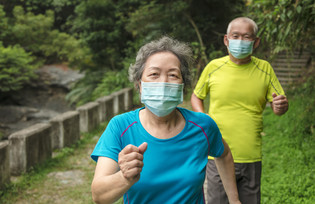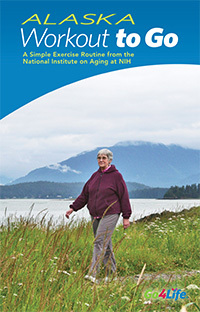March 2021
Having trouble viewing this email? View it as a Web page.
Alaska’s Injury Prevention program strives to prevent falls and improve older adults’ independence and health
 Falling is the most common injury that leads to Alaskans ages 55 and older needing to go to the hospital, or in some cases dying. Alaska’s Injury Prevention program and its partners support and provide services to prevent those falls, improving older adults’ confidence, independence and ability to keep doing the activities they enjoy.
In 2018, 37 older Alaska adults died and 1,208 were hospitalized from injuries caused by a fall, according to Alaska Vital Statistics 2018 Annual Report. Falling can lead to other consequences for adults, including restricting their movements out of fear of another fall. Cutting back on activity overall can limit adults’ physical capabilities and ultimately increase their chances for another fall due to reduced muscle tone and mobility.
Many strategies can help prevent falls
The goal of fall prevention efforts supported by Alaska’s Injury Prevention Program is to keep older Alaskans in their homes and communities, and to improve their quality of life. These efforts can be categorized as behavioral, environmental and medical interventions.
Behavioral interventions include those activities such as healthy eating, moderation in drinking alcohol, and increased physical activity that can reduce the chances of falling. Regular physical activity reduces the chances of falling by improving strength, endurance, flexibility, and balance. Adults can be active at home or outside in Alaska’s many open spaces.
Environmental changes include removing tripping hazards, installing grab bars and improving lighting in an older adult’s home. Possible modifications include adding grab bars in the bathroom, removing clutter from stairs and walkways, and ensuring areas outside are free of ice. Simply adding better lighting in a house and ensuring power cords are not in a walking area can help prevent tripping hazards. Alaska has a number of Aging and Disability Resource Centers. These centers connect seniors, people with disabilities and caregivers with long-term services and support.
Medical interventions involve working with a health care provider to identify drugs the person may be taking that impact balance, checking and correcting vision issues, and testing balance and examining feet. Health care providers can discuss changes with older adults and their family members during visits. Vitamin D and calcium supplements may be recommended to improve bone strength.
In some Alaska communities, caregivers visit older adults to provide health assessments and home safety checks. Community Health Aides (CHAs) in rural Alaska are trained to do home safety checks and patient assessments for higher risks of falling. When funding allows, regional programs provide ice cleats, mobility devices like canes and walkers, and other equipment like grab bars for a bathroom to prevent falls among older Alaskans. Some communities also have programs that provide meals and physical activities for local older adults.
Find more helpful resources for adults, caregivers and providers
The Alaska Injury Prevention program and its partners offer many helpful resources to prevent falls.
Resources for older adults:
 |
|
- Prevent falls by keeping fit. Use the Alaska Workout to Go booklet to create a simple physical activity routine that is easy to follow and focuses on strength, balance, and flexibility exercises that you can do anytime, anywhere.
|
- The National Council on Aging created a Falls Free CheckUp Tool for adults who want to assess their risk of falling. This online, interactive tool includes 12 questions to assess someone’s risk of falling. It gives a personalized report of the results to share with a health care provider.
Resources for caregivers:

- The National Council on Aging has produced a Falls Prevention Awareness Week Toolkit. The kit includes resources to use in an older adult’s home and strategies to talk about reducing falls-related injuries in communities.
- The University of Alaska, Anchorage’s Center for Human Development has created a new Fall Prevention Training for Direct Service Providers. This training and the resources shared will teach direct service providers, caregivers, and even family members fall prevention strategies and how to use them. The training includes a self- assessment tool to evaluate the safety of the environment in an assisted living home (ALH) or client's home.
Alaska’s Injury Prevention program sponsors this training, which offers a certificate of completion and is offered with NO FEE until July 1, 2021.
Resources for providers:
|

- The Centers for Disease Control and Prevention (CDC) has developed a toolkit for providers to help prevent an older adult’s chance of falling. This STEADI (Stopping Elderly Accidents, Deaths & Injuries) Initiative offers brochures, videos and additional resources for providers to assess and help their older patients. Find out more at this website: https://www.cdc.gov/steadi/patient.html
|
For more information about the Injury Prevention Program or Adult Fall Prevention in Alaska, go to our website or email: hss.injuryprevention@alaska.gov |